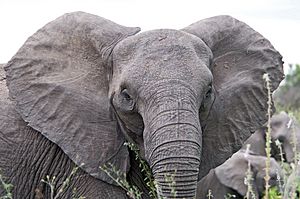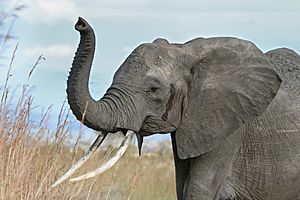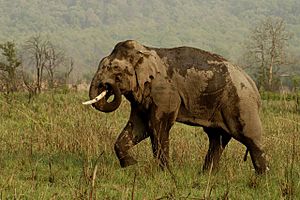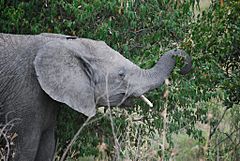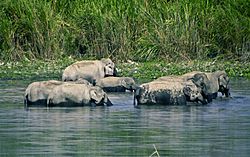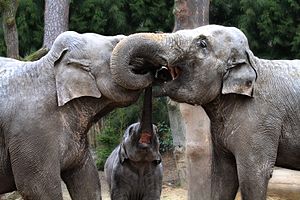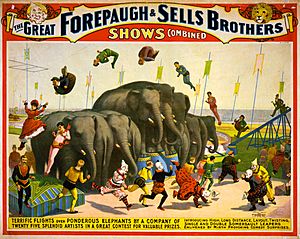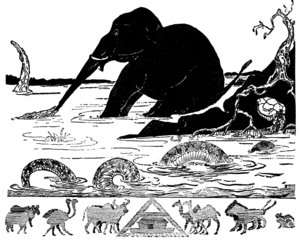Elephant facts for kids
Quick facts for kids Elephants
|
|
|---|---|
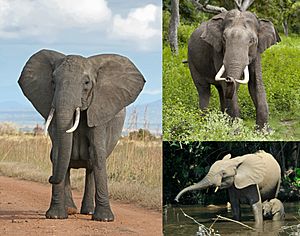 |
|
| From top left to right: the African bush elephant, the Asian elephant and African forest elephant. | |
| Scientific classification | |
| Kingdom: | Animalia |
| Phylum: | Chordata |
| Class: | Mammalia |
| Order: | Proboscidea |
| Family: | Elephantidae |
| Subfamily: | Elephantinae |
| Groups included | |
| Cladistically included but traditionally excluded taxa | |
|
|
Elephants are the biggest land animals alive today. The largest elephant ever recorded was found in Angola in 1974. It weighed about 13.5 tons and stood 13 feet 8 inches tall. Elephants usually have grey skin.
When a baby elephant is born, it can weigh around 100 kilograms (225 pounds). The baby grows inside its mother for 20 to 22 months. No other land animal takes this long to develop before being born.
In the wild, elephants have very strong family bonds. They communicate with each other using very low sounds. Most of these sounds are too low for humans to hear. But elephants can hear them from far away.
Contents
How Elephants Evolved
Elephants are related to sea cows, which are large water mammals. Early elephant ancestors lived in the Paleocene and Eocene periods. They were small, semi-aquatic animals. By the Miocene period, larger forest-dwelling elephants like gomphotheres and deinotheres appeared. Their teeth show they ate soft forest plants.
Modern elephants, including mammoths and mastodons, came from gomphotheres. This happened as the climate got cooler and drier in the Pliocene and Pleistocene times.
Gomphotheres lived for a long time and were hunted by early humans. As forests shrank and grasslands grew, elephants that ate grass became more common. This change in food was one reason gomphotheres died out in South America. The last ones likely disappeared due to climate change or human hunting.
Modern elephants, especially Asian elephants, mostly eat grass. This is different from gomphotheres, whose teeth were made for eating softer plants.
Elephant Body and Features
Elephants are the largest land animals alive. African elephants are 3 to 4 meters (10-13 feet) tall and weigh 4,000 to 7,000 kilograms (8,800-15,400 pounds). Asian elephants are a bit smaller, standing 2 to 3.5 meters (6.5-11.5 feet) tall and weighing 3,000 to 5,000 kilograms (6,600-11,000 pounds). Males are always bigger than females.
African forest elephants are smaller than African savanna elephants. An elephant's skull is very strong. It can handle the force from their tusks and head-to-head fights. Their neck is short to help support their large head.
Elephants see well in dim light but not in bright light. Their body temperature is about 35.9°C (97°F), similar to humans. Like camels, elephants can change their body temperature a few degrees to handle extreme heat or cold.
Elephant Ears
Elephant ears are thick at the base and thin at the tips. The ear flaps have many tiny blood vessels. To cool down, warm blood flows into these vessels. This releases heat into the air. Elephants can flap their ears to speed up this cooling.
Larger ears have more blood vessels, so more heat can escape. African bush elephants live in the hottest places. This is why they have the largest ears. Elephants can hear very low sounds that humans cannot.
Elephant Trunk
An elephant's most noticeable part is its trunk. The trunk is a very long nose, made from its upper lip. Elephants use their trunk to grab objects like food. While an elephant's skin is thick, its trunk is very soft and sensitive. Elephants avoid Acacia trees with ants. These ants can bite the inside of an elephant's trunk.
Elephant Teeth and Tusks
Elephants also have tusks. Tusks are large teeth that grow out of their upper jaw. A lot of ivory comes from elephant tusks. Sadly, ivory traders killed many elephants. Because of this, hunting elephants is now illegal. The trunk is also used when an elephant trumpets. The elephant stands still, raises its trunk, and blows. This is a signal to other elephants and wildlife.
African elephants are larger and have bigger ears. They eat leaves, branches, and grass. Their big ears have many veins. These veins carry blood throughout the body. Scientists think the blood flowing through their ears helps African elephants stay cool. Africa's weather is hotter than Asia's. Female African elephants have tusks, but female Asian elephants usually do not. African elephants have a dip in their back. African elephants have two "fingers" at the end of their trunks. Asian elephants only have one. Asian elephants mainly eat grass.
Grass wears down their teeth because it contains silica and is very abrasive. Elephants use their teeth one at a time. They only have one tooth in each jaw at any given time, for a total of four.
In total, they have 24 teeth. These include 12 front teeth called premolars and 12 back teeth called molars. When the last molar wears out, the elephant cannot eat and dies. Elephants can live for about 70 years. In a zoo or circus, people can keep elephants alive longer by feeding them soft food.
Elephant Tusks
Elephant tusks are changed incisor teeth in the upper jaw. They replace baby teeth when the elephant is 6–12 months old. Tusks grow continuously, about 17 centimeters (7 inches) each year.
Tusks have many uses. Elephants use them to dig for water, salt, and roots. They also use them to remove bark from trees or mark trees. Tusks help move trees and branches to clear a path. They are also used as weapons for fighting and for protecting the trunk.
Like humans who are right- or left-handed, elephants are usually right- or left-tusked. The main tusk, called the master tusk, is usually shorter and more worn down. Both male and female African elephants have tusks. They can grow over 3 meters (10 feet) long. Male tusks tend to be thicker. In Asian elephants, only males have large tusks. Female Asian elephants have very small tusks or none at all.
The ivory from African forest elephants is very hard. Hunting for ivory in Africa might be causing elephants to have shorter tusks over time.
Elephant Skin
An elephant's skin is very tough. It can be 2.5 centimeters (1 inch) thick on its back and head. Young elephants have brownish or reddish hair, especially on their head and back. Asian elephants usually have more hair on their skin than African elephants.
Elephants typically have grey skin. But African elephants can look brown or reddish after rolling in colored mud. Even though their skin is tough, it is very sensitive. Without regular mud baths, their skin can get sunburned, bitten by insects, or dry out. After bathing, elephants often blow dust onto their bodies with their trunks. This dust dries into a protective layer.
Elephant Legs and Movement
To support their heavy weight, an elephant's legs are placed almost straight under its body. This allows elephants to stand still for a long time without using much energy.
Elephant feet are round and have soft tissues or "cushion pads" underneath. These pads help spread out the animal's weight. Elephants can have up to five toenails on both their front and back feet. Elephants also have an extra "toe" that helps support their weight.
Elephants can move forwards and backwards. But they cannot trot, jump, or gallop. They use two main ways of moving on land: a walk and a faster gait that is like running. When walking, their legs swing like pendulums. In the faster gait, they move their legs like other running animals. Fast elephants seem to "run" with their front legs but "walk" with their back legs. They can reach speeds of up to 18 kilometers per hour (11 miles per hour).
When elephants move, their cushion pads expand and shrink. This reduces pain and noise from such a heavy animal. Elephants are also good swimmers. They have been known to swim for up to six hours without touching the bottom. They can travel as far as 48 kilometers (30 miles) at speeds of 2.1 kilometers per hour (1.3 miles per hour). Elephants usually sleep lying down, but they can also doze while standing.
Elephant Behavior
African bush elephants live in many different places. These include dry savannas, deserts, marshes, and mountain areas. Forest elephants mainly live in equatorial forests. Asian elephants prefer areas with a mix of grasses and trees. They live in dry thorn-scrub forests in India and Sri Lanka.
Elephants are herbivores. This means they eat plants. They eat leaves, twigs, fruit, bark, and roots. African elephants mostly eat leaves and branches. Asian elephants mainly eat grass. They can eat up to 150 kilograms (330 pounds) of food and drink 40 liters (10.5 gallons) of water every day. Elephants usually stay close to water. They eat a lot in the morning, afternoon, and night. In the middle of the day, they rest under trees and might nap while standing. They sleep at night while lying down.
Both male elephants and family groups usually travel 10 to 20 kilometers (6-12 miles) a day. But they have been known to travel much farther, up to 180 kilometers (112 miles). They go on seasonal trips to find food, water, and mates. At Chobe National Park in Botswana, elephant herds travel 325 kilometers (200 miles) to reach the river when local waterholes dry up.
Because they are so big, elephants have a huge effect on their environment. They are called keystone species. When they pull up trees and plants, they can turn savannas into grasslands. When they dig for water during dry times, they create waterholes for other animals. They can also make waterholes bigger when they bathe and roll in them. At Mount Elgon, elephants dig caves that other animals use.
Elephants also help spread seeds. When African forest elephants eat seeds and then poop them out, it often helps the seeds grow. In Asian forests, large seeds need giant plant-eaters like elephants to carry and spread them. This job cannot be done by smaller animals. Since much of the food they eat is not digested, their poop provides food for other animals, like dung beetles and monkeys.
However, elephants can also harm ecosystems. In Murchison Falls National Park in Uganda, too many elephants have threatened small bird species that need woodlands. Also, their weight can pack down the soil. This causes rain to run off instead of soaking in, leading to erosion.
Adult elephants are almost safe from predators because of their size. But baby elephants can be hunted by lions, spotted hyenas, and wild dogs in Africa. In Asia, tigers might hunt them. Lions in Savuti, Botswana, have learned to hunt elephants during the dry season. A group of 30 lions was seen killing elephants aged four to 11 years.
Elephants usually get along with other plant-eating animals. Other animals tend to stay out of their way. Sometimes, elephants and rhinoceroses have fought. At Aberdare National Park, Kenya, a rhino attacked a baby elephant. The other elephants in the group then killed the rhino. Elephants tend to have many parasites, like nematodes. This is because fewer predators hunt elephants with many parasites.
Elephant Family Life
A female elephant usually has one baby, called a "calf," every four or five years. Calves are born about 85 centimeters (33 inches) tall and weigh around 120 kilograms (265 pounds). An elephant's pregnancy lasts about 22 months. Another female elephant often stays with the new mother until the baby is born. The newborn elephant can often stand within 30 minutes of birth. Mother elephants gently touch their babies with their trunks. It takes a baby a year or more to learn how to control its trunk.
Baby elephants drink their mother's milk for the first two years of their lives. After birth, the baby's first action is to wobble and find its mother's milk. It drinks about 10 liters (2.6 gallons) of milk every day.
Elephants live long lives, reaching 60–70 years old. Lin Wang, an Asian elephant in captivity, lived for 86 years.
Elephant Communication
Touching is a key way elephants communicate. They greet each other by stroking or wrapping their trunks. Older elephants use trunk-slaps, kicks, and shoves to teach younger ones.
Elephants try to look more threatening by raising their heads and spreading their ears. They might also shake their heads, snap their ears, and throw dust or plants. They are usually just pretending when they do this. Excited elephants may also raise their trunks.
Elephants make many sounds. The most famous is the trumpet. They make this sound when excited, stressed, or angry. Fighting elephants may roar or squeal. Wounded elephants might bellow.
Elephant Intelligence
Elephants are among the smartest animals. Their thinking is similar to primates. They can recognize themselves in a mirror. This shows self-awareness and cognition, also seen in some apes and dolphins.
An Asian elephant was seen changing branches to use them as flyswatters. Elephants can use tools, but not as skillfully as chimpanzees.
People often say elephants have excellent memories. This might be true. They may have "mental maps" to remember large areas for a long time. Also, elephants seem to know where their family members are at all times.
Elephant Conservation
Elephant Status
Both African and Asian elephants are endangered species. This means their populations are at risk.
African elephants have legal protection in every country where they live. However, 70% of their habitat is outside protected areas. Efforts to protect them have led to more elephants in some places.
Large-scale culling (legal killing) stopped in 1988. In 1989, trading elephants and their products (like ivory and meat) became illegal. Some countries were later allowed to have limited trade. In some countries, hunting elephants for sport is legal. The IUCN estimated about 440,000 African elephants in 2012.
The total number of Asian elephants is about 40,000–50,000. About half of them live in India. While Asian elephant numbers are decreasing overall, especially in Southeast Asia, the population in the Western Ghats might be growing.
Threats to Elephants
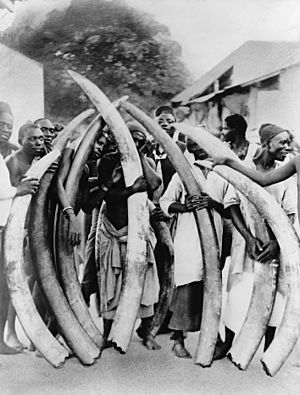
The poaching of elephants for their ivory, meat, and hides has been a major threat. Historically, many cultures made art from elephant ivory. Hunting for ivory caused African elephant numbers to drop in the late 1900s. This led to international bans on ivory imports. The United States banned it in 1989, followed by other countries. Around the same time, Kenya destroyed all its ivory. An international ban on ivory began in January 1990.
After the bans, some countries like India and China faced economic problems. But Japan and Hong Kong, also involved in the ivory trade, adapted well. Some countries were allowed to continue limited ivory trade if their elephant populations were healthy. This was only for elephants that died naturally or were culled. The ban helped African elephants recover in some parts of Africa. In 2012, hundreds of elephants in Bouba Njida National Park, Cameroon, were killed by raiders. This was one of the worst killings since the ivory ban. Asian elephants are less affected by the ivory trade because females usually do not have tusks. Still, some have been killed for ivory in places like Periyar National Park, India.
Other threats to elephants include habitat destruction and fragmentation. This leads to conflicts with humans. Asian elephants live in areas with many people. Because they need large areas of land, they are the first to be affected when humans expand. Elephants may end up stuck in small forest areas surrounded by human towns. Also, elephants cannot live with humans in farming areas because of their size and food needs. Elephants often step on and eat crops. This causes conflicts, and both elephants and humans have died. Reducing these conflicts is important for elephant protection.
Elephants and Humans
Elephants as Working Animals
Elephants have been used as working animals since ancient times. Today, 13,000–16,500 working elephants are used in Asia. These animals are usually caught from the wild when they are 10–20 years old. At this age, they can be trained easily and will work for a long time. They were traditionally caught with traps and ropes. Since 1950, tranquilizers have been used, which are less harsh. Elephants do jobs like carrying heavy loads to remote areas. They move logs, transport tourists in national parks, pull wagons, and lead religious parades.
Elephants in Warfare
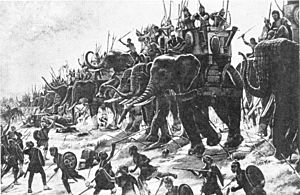
Elephants were powerful tools in ancient wars. They wore armor to protect their sides. Their tusks were sometimes given sharp iron or brass points. War elephants were trained to grab enemy soldiers and throw them to their riders. They could also pin soldiers to the ground and stab them.
Elephants in Zoos and Circuses
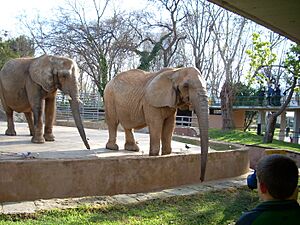
Elephants were historically kept in menageries (animal collections) in Ancient Egypt, China, Greece, and Rome. The Romans even made elephants fight humans and other animals in gladiator events. In modern times, elephants have been a big part of zoos and circuses. In circuses, they are trained to do many tricks. As of 2000, about 1,200 Asian and 700 African elephants live in zoos and circuses. The largest group of captive elephants is in North America.
Keeping elephants in zoos has caused some debate. Supporters say zoos help researchers study animals. They also provide money and knowledge to protect elephants in the wild. Critics say that elephants in zoos can experience physical and mental stress.
Elephants in Culture
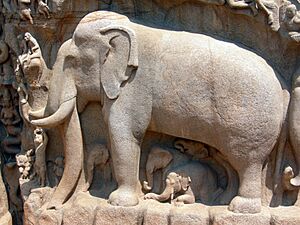
Elephants have been shown in art since ancient times. Africa has many rock paintings and carvings of elephants. In the Far East, elephants are important symbols in Hindu and Buddhist temples.
It was often hard for people who had never seen an elephant to draw them. The ancient Romans, who kept elephants, drew them accurately on mosaics. In the Middle Ages, Europeans had little access to elephants. So, they drew them more like fantasy creatures. They were often shown with horse-like bodies, trumpet-like trunks, and boar-like tusks. Some even had hooves.
As more elephants were sent to European kings in the 15th century, drawings became more accurate. Leonardo da Vinci even drew one. Despite this, some Europeans still drew them in a more artistic way. Max Ernst's 1921 painting The Elephant Celebes shows an elephant as a silo with a hose for a trunk.
Elephants are also important in religious beliefs. The Mbuti people believe their ancestors' souls live in elephants. Other African tribes believed their chiefs would be reincarnated as elephants. In the 10th century AD, the people of Igbo-Ukwu buried their leaders with elephant tusks.
Elephants are very important in Asian religions. In Sumatra, elephants are linked with lightning. In Hinduism, they are linked with thunderstorms. Airavata, the father of all elephants, represents lightning and rainbows. One of the most important Hindu gods is Ganesha, who has an elephant head. Ganesha is linked with writers and merchants. People believe he can bring success and grant wishes. In Buddhism, Buddha is said to have been a white elephant in a past life. In Islamic tradition, the year 570, when the Prophet Muhammad was born, is known as the Year of the Elephant. Romans thought elephants were religious. They believed elephants worshipped the sun and stars.
The elephant became a symbol of the US Republican Party in an 1874 cartoon by Thomas Nast.
Elephants are often characters in children's stories. Many stories tell of young elephants returning to their families. Examples include "The Elephant's Child" from Rudyard Kipling's Just So Stories, Disney's Dumbo, and The Saggy Baggy Elephant. Other famous elephant heroes are Jean de Brunhoff's Babar, David McKee's Elmer, and Dr. Seuss's Horton.
Images for kids
-
Parable of the elephant and the blind monks; illustrated by Hanabusa Itchō. (Ukiyo-e woodcut, 1888)
See Also
 In Spanish: Elefantes para niños
In Spanish: Elefantes para niños




